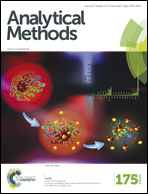Rapid detection and identification of bacterial meningitis pathogens in ex vivo clinical samples by SERS method and principal component analysis†
Abstract
Three of the most common meningitis pathogens, Neisseria meningitidis, Haemophilus influenzae, and Streptococcus pneumoniae, have been successfully detected and identified in clinical cerebrospinal fluid (CSF) samples using a new class of a surface-enhanced Raman scattering (SERS) assay. Bacterial meningitis is a disease of the nervous system that is extremely serious and often fatal (an inflammation encompasses the lining around the brain and spinal cord). The approach presented in this study challenges the current SERS-based method of microorganism detection in terms of sensitivity and, more importantly, reveals a simple, quick (on a timescale of seconds), label-free detection of multiple components from very small volumes of clinical samples. This new SERS class of assay, based on the combination of two types of Au/Ag-coated, nuclepore track-etched polycarbonate membranes, allow simultaneous filtration of CSF and immobilization of CSF components, enhancing their Raman signals and enabling detection of the spectra of a single bacteria cell present in the analyzed CSF samples. The multivariate statistical method, principal component analysis (PCA), was applied (i) to extract the biochemical information from the recorded bacterial spectra, (ii) to perform the statistical classification of analyzed microorganisms, and, finally, (iii) to identify the spectrum of an unknown sample by comparing it to the library of known bacterial spectra. The three meningitis pathogens, namely, N. meningitidis, H. influenzae, and S. pneumoniae, were detected and identified simultaneously using a label-free SERS method. This method of detection produces consistent results faster and cheaper than traditional laboratory techniques and demonstrates the powerful potential of SERS technique in medical applications. Additionally, the present study was undertaken to evaluate the CSF neopterin level in patients with diagnosed meningococcal meningitis. The results of this study confirmed that bacterial meningitis caused by N. meningitidis, H. influenzae, and S. pneumoniae is associated with elevated cerebrospinal fluid neopterin levels compared with control CSF samples. The neopterin concentration can be used to predict meningitis, but cannot be applied to qualify the species of bacteria inducing the meningitis infection.


 Please wait while we load your content...
Please wait while we load your content...